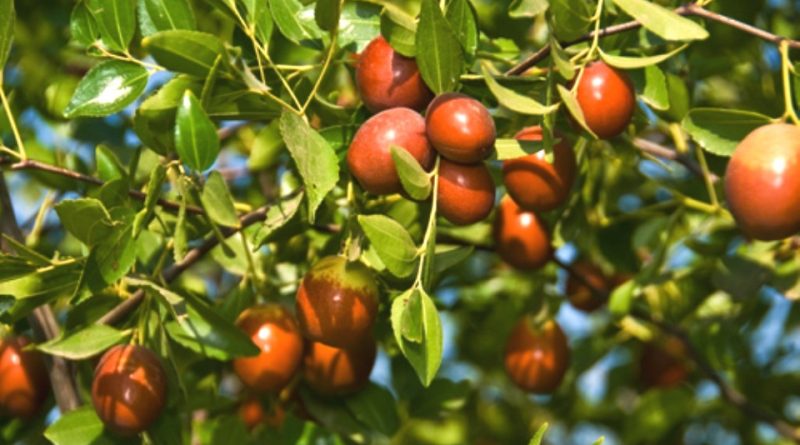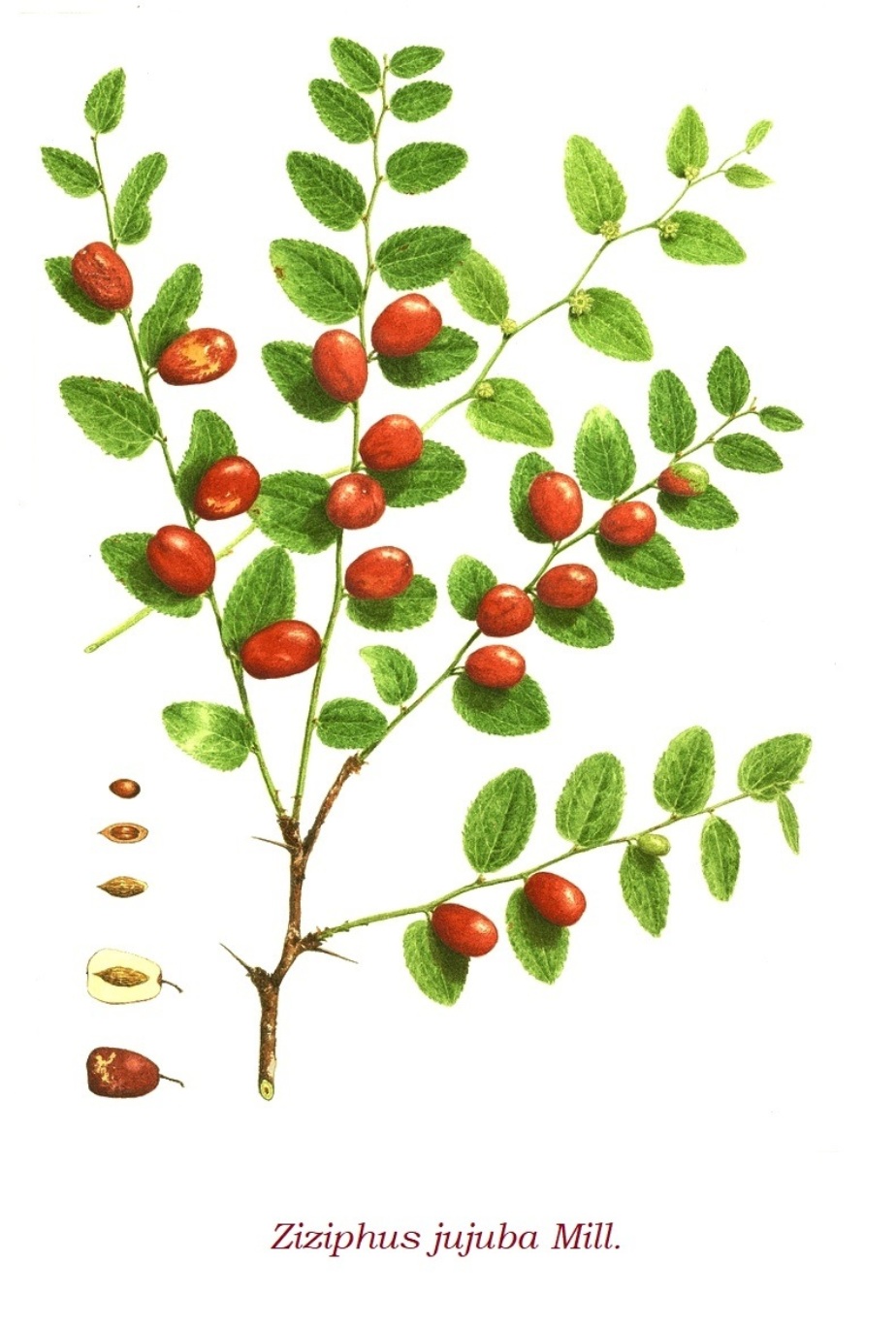Ziziphus jujuba
Ziziphus jujuba
The jujube (Ziziphus jujuba Mill.) Is a fruit tree species belonging to the Rhamnaceae family.
Systematics –
From the systematic point of view it belongs to the Eukaryota Domain, Kingdom Plantae, Magnoliophyta Division, Magnoliopsida Class, Order Rhamnales, Family Rhamnaceae and therefore to the Genus Ziziphus and to the Species Z. jujuba.
Etymology –
The term zíziphus we find it as ziziphum in Pliny, Clumella & al., From the Greek ζιζυφον zízyphon: probably referring to Ziziphus lotus, a plant mentioned in numerous ancient texts and at the base of the famous myth of the lotophagus mentioned in the Odyssey. The specific epithet jujuba is instead the Latinized form of the Arabic name of the jujube.
Geographic Distribution and Habitat –
Ziziphus jujuba is a naturally occurring species in central Asia and the Caucasus region. Outside this area the jujube, even if natural, comes from plants grown also as a residual presence. Its origin would seem to be allocated between North Africa and Syria, and that it was subsequently exported to China and India, where its cultivation has been going on for over 4000 years.
Description –
The Ziziphus jujuba is a deciduous deciduous tree species that, under natural conditions, can take the shape of a tree and sometimes that of a shrub; the plant can reach the natural state at 8-12 meters. The leaves are rounded, light green and bright. It has a very deep root system and has a very articulated and twisted trunk and branches, with a flaking bark; the branches are covered with thorns. The flowers are numerous, small in size and with a greenish white color; the flowering is between June and August while the fruits ripen between September and October and are drupes with a single seed of the size of an olive, with red to brown colored exocarp and yellowish endocarp.
Cultivation –
The jujube is a tree is able to survive cold winters, with temperatures up to -15 ° C and does not have particular needs of soil. It is a species with very slow but also very long-growing growth. In Japan and China, where the jujube is more cultivated, there are many varieties that differ in shape and size of the fruit. For the cultivation technique you can consult the present sheet.
Uses and Traditions –
The jujube was imported by the Romans who called it ziziphum (from the Greek ζίζυφον, zízyphon). but it was then spread mainly by the Venetians, who imported it directly from the east and spread it first in Dalmatia and then on the islands of the lagoon on the mainland and on the Euganean Hills.
In the past it was used, in some Italian regions, to make defensive hedges in the borders of the plots, especially for the presence of the dense network of minute branches of thorns. It is often used as an ornamental plant. In Veneto, on the Euganean Hills, there is a more intensive cultivation that has been established in recent years. Ziziphus jujuba is a mellifera plant much visited by bees; but it is difficult to produce monofloral honey due to the sporadic presence of the plant.
It is probable that the lotus of which Homer speaks is precisely the Zizyphus lotus, a wild jujube, and that the enchantment of the Lotophages was not caused by narcotics but only by the alcoholic drink that can be prepared with the fruits of the jujube. For the ancient Romans instead the jujube was to be the symbol of silence and, for this reason, adorned the temples of the goddess Prudenza.
In ancient times it was planted in some regions adjacent to the house, because it claimed it was a lucky plant.
Herodotus reports that the jujube could be used, after fermentation, to produce a wine, whose oldest preparations date back to Egyptians and Phoenicians.
In jujube is zizifin which is a triterpenic glucoside that suppresses the perception of sweet taste in humans.
Jujubes not yet ripe have a taste similar to that of apples, are rich in vitamin C and with maturation the flavor becomes more similar to that of a date. The core of the fruit, similar to that of an olive, in Persian cuisine is called annab.
Connected to the fruit of the jujube there is a famous expression: “go to the broth of jujube”. This way of saying has a very ancient origin, already mentioned in the seventeenth century in the first Italian language dictionary, but few know what “jujube broth” is and most people have never had the opportunity to taste the fruit of the jujube.
The ancient saying, of uncertain origin, is still widely used to indicate a mood of great satisfaction and enjoyment. “Going into the jujube soup” is a figurative expression that means “going to solluchero, coming out of oneself almost from contentment” and its origin is an alteration of the expression of Tuscan origin “go to broth (or broth) of suckles “. The use of this original expression appears in the first edition of the Vocabulary of the Academics of the Crusca (1612), where it is mentioned twice: under the heading ‘succiare’, with an example taken from the “Morgante” by Luigi Pulci, and in the voice chestnut, where ‘succeola’ means the chestnut cooked in water with its peel.
The transformation from “broth of suckers” to “broth of jujube”, that is the fruits of the jujube plant, is hypothesized to have occurred due to the spread that these had both in medicine, where they found a useful application in the form of cough decoctions and other diseases of the respiratory tract, both in the kitchen, for the preparation of delicious jams and jams, thus taking the place of the “succiole”, or boiled chestnuts.
Therefore, the state of contentment to which the two proverbial words “go in jujube broth” and “go in suction broda” refer both to the goodness of the fruits mentioned.
Preparation Mode –
Jujube can be consumed like normal fruit, both in its still unripe form and as a very sweet ripe fruit. Noto is the “Brodo di Giuggiole” an infusion of jujubes and autumn fruits, such as Moscato grapes, quinces, lemon peel, grapes and pomegranates. It seems that this recipe derives from a preparation in vogue at the Gonzaga in the Renaissance, which used to delight guests with a liqueur based on these fruits.
Jujube, however, can be used for the preparation of jams, jams, to flavor grappa and liqueurs or preserved in spirit.
Guido Bissanti
Sources
– Wikipedia, the free encyclopedia.
– Treben M., 2000. Health from the Pharmacy of the Lord, Advice and experience with medicinal herbs, Ennsthaler Publisher
– Pignatti S., 1982. Flora of Italy, Edagricole, Bologna.
– Conti F., Abbate G., Alessandrini A., Blasi C. (edited by), 2005. An annotated checklist of the Italian vascular flora, Palombi Editore.
Warning: Pharmaceutical applications and alimurgical uses are indicated for informational purposes only and do not in any way represent a medical prescription; there is therefore no liability for their use for curative, aesthetic or food purposes.


